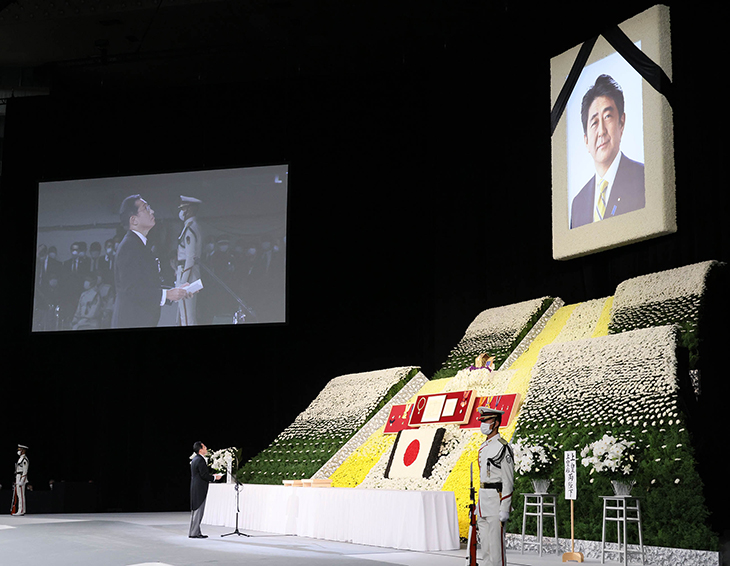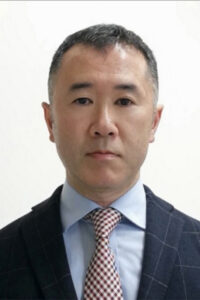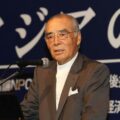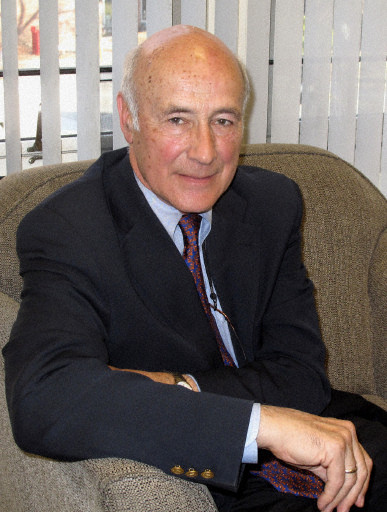The Lost Balance: On the “Three Lines” of Modern Japanese Diplomacy

The current situation in Japanese foreign affairs may be termed “Abe’s strong line without Abe.”
“I believe it is time to break away from the past decade’s rigid framework of being polarized between supporting Abe or being opposed to Abe, instead consciously stimulating flexible thinking and discussion.”
Photo shows the State Funeral for the late Prime Minister Abe Shinzo in 2022, Cabinet Public Affairs Office
Miyagi Taizo, Professor, Chuo University
The current situation of “Abe’s strong line without Abe”
What have been the trends and directions of Japanese diplomacy in recent years? And what kind of diplomatic line may await Japan in the future? In this paper, I position foreign relations after the Koizumi Junichiro administration (2001–2006), meaning during and beyond the First Abe Shinzo administration (2006–2007), as contemporary, or modern, Japanese diplomacy directly related to the current situation.
Iokibe Makoto, a diplomatic historian, once argued that there were three lines of Japanese postwar diplomacy: the “social democratic line,” “the economocentric line,” and the “traditional state line” (Iokibe Makoto ed. Sengo Nihon gaikoushi (The Diplomatic History of Postwar Japan), Yuhikaku). The “social democratic line” was a diplomatic initiative of the Japan Socialist Party, which advocated unarmed neutrality, and the “economocentric line” was the “Yoshida Doctrine” of light arms and economic focus. The “traditional state line” was spearheaded by Hatoyama Ichiro (1883–1959) and Kishi Nobusuke (1896–1987), politicians who had been influential since before the war, who advocated the establishment of an independent constitution and full-scale rearmament.
If we try to compare the current era to the perspective of these “three lines,” we can see that there have been three diplomatic lines represented by Abe Shinzo, Fukuda Takeo, and Hatoyama Yukio in recent times in Japan. After the collapse of the Democratic Party of Japan (DPJ) and the second Abe administration that lasted nearly eight years, the two lines other than that represented by Abe have fallen to the wayside, so that the current situation in Japanese foreign affairs may be termed “Abe’s strong line without Abe.” I would like to ponder what this means for Japanese diplomacy.
What have been the “three lines” of modern Japanese diplomacy?
First, I need to explain the three lines. To begin with, the line of Hatoyama Yukio, which is relatively easy to picture, was characterized by the controversial “East Asian Community” that wanted to relocate the US Futenma Air Base in Okinawa at least outside the prefecture, as if to chase away the United States, as well as the “emergency stationing theory” of Japan-US security and “emphasis on the United Nations” advocated by Ozawa Ichiro and others. In the context of recent discourse, all of this may perhaps be dismissed as wishful thinking.
Next are the lines represented by Abe Shinzo and Fukuda Yasuo. Since the outbreak of the war in Ukraine, the possibility of a Taiwan emergency has been talked about with increased urgency, but the statements of Abe and Fukuda were in stark contrast with each other.
Abe brought up nuclear sharing immediately after the outbreak of the war in Ukraine, perhaps with the intention of bringing some attention to himself after retiring as prime minister, but a few years before that, at a meeting of senior officials of the Ministry of Foreign Affairs and the Ministry of Defense at the Prime Minister’s Office, he opened by clearly saying, “You guys, we can beat China, right?” and then, “A Taiwan emergency is an emergency for Japan” (Mainichi shimbun, January 2, 2023).
By contrast, Fukuda said, “Under the tense situation [of the war in Ukraine], Japan must strive to avoid provoking the international community, including neighboring countries,” “If this continues, Japan and China may (end up) in a relationship that necessitates both sides strengthening their armaments,” and “Will Japan be able to keep going if that happens?” (Political Premier, Mainichi shimbun, January 1, 2023).
Of course, it would be rash to characterize the diplomatic stances of either Abe or Fukuda solely based on these statements. Although Abe is often seen as a hardliner against China, the greatest achievement in his short-lived first administration was an improvement in Japan-China relations, which had cooled due to Prime Minister Koizumi’s visit to Yasukuni Shrine, and it has been pointed out that Japan-China relations were also improving during his second administration (although these improved relations appear to have been guided by the Chinese in both instances).
Abe and Fukuda under the Koizumi administration
Nonetheless, Abe and Fukuda seem to represent two trends in Japanese diplomacy in recent years. Specifically, while Abe’s line was characterized by strength and resoluteness that is easy to understand, intended to appeal to Japanese public opinion, Fukuda’s line was one of dialogue and coexistence, based on the premise that diplomacy is conducted with another party. The characteristics of each came to manifest strongly in relations with China and other neighboring Asian countries.
Both of their diplomatic starting points were the Koizumi administration. Abe and Fukuda belong to the LDP and the party’s Seiwa Political Analysis Council (Seiwa kai). In the Koizumi administration, then Chief Cabinet Secretary Fukuda was also in charge of diplomacy, while Abe was appointed as Deputy Chief Cabinet Secretary and came to be in the spotlight in connection with the North Korea abduction issue. This became the starting point of Abe’s diplomacy.
With Koizumi’s visit to North Korea in 2000, public opinion in Japan was outraged when it was revealed that many of the abduction victims were already deceased. Meanwhile, the surviving abduction victims returned to Japan “temporarily.” The question was asked if the abduction victims ought to be returned to North Korea as promised?
The Japan-DPRK Pyongyang Declaration at the time of the visit to North Korea also called for negotiations to normalize diplomatic relations. While the Ministry of Foreign Affairs maintained that “The relationship of trust between Japan and North Korea will collapse and Japan-North Korea talks will not be possible,” Abe, who had been working on the abduction issue for some time, insisted that it would be outrageous to hand the victims over to North Korea again. Koizumi gave Abe the thumbs up. Abe had a strong distrust in Japanese diplomacy, which he felt had been too considerate of neighboring Asian countries with which Japan has historical issues, and was failing to say what needed to be said. Having strengthened his position here, Abe used the catchphrase “fighting politician” to quickly climb the political ladder.
On the other hand, Fukuda strongly opposed Prime Minister Koizumi’s return visit to North Korea in 2004. The reason was to bring back the families of abduction victims who had settled in Japan, but Koizumi took the advice of his trusted secretary also with the hope that it would help the government ahead of the Upper House election. Fukuda was also very angry at the idea of diplomacy being used to gain popularity for election purposes, and at the fact that “dual diplomacy” was carried out without his knowledge as Chief Cabinet Secretary. Ahead of the return visit in May of the same year, Fukuda abruptly resigned as Chief Cabinet Secretary, citing non-payment of his pension. Abe’s belief in the importance of a resolute stance and strong assertiveness prominently contrasted with Fukuda’s warning against the political use of diplomacy.
Dealing with the rise of China
Koizumi was succeeded by Abe. Worried about Abe’s hardline diplomatic stance, Fukuda seems to have had ambitions of his own, but a confrontation between the two would likely have focused on diplomacy in Asia, including the pros and cons of visiting Yasukuni Shrine. Yet as Fukuda did not want a split in national discourse, he decided not to run, although he said, “I’m number two, a spare, and I might be able to step in if the top falls. Our ideas are entirely different, but without a person like him, the LDP will be in danger.” In fact, the first Abe administration ended after just over a year, and Fukuda became prime minister.
During this period, how to deal with the rapid rise of China increasingly became a major factor in shaping diplomacy. The first Abe administration’s “value-oriented diplomacy” and “Arc of Freedom and Prosperity” emphasized values such as democracy and human rights, seeking to draw an arc founded on freedom and prosperity from Japan to Southeast Asia and India along the southern edge of the Eurasian Continent, seemingly encircling China.
By contrast, Fukuda as prime minister promoted the Japan-US alliance and “synergy diplomacy” with the rest of Asia based on the recognition that working on relations with both the US and China will lead to stability in the Asian region. Fukuda and China’s President Hu Jintao visited each other, and although both were eager to improve relations, the Fukuda administration’s footing was vulnerable due to the “divided Diet” lacking a majority in the Upper House.
Aso Taro, who succeeded Fukuda as prime minister, revived the “value-oriented diplomacy” and “Arc of Freedom and Prosperity” that he had advocated when serving as foreign minister in the first Abe administration. When the Hatoyama administration came about in the first full-scale change of government since the war, it promoted the “East Asian Community” instead.
It was a time when catchphrases were being launched at a dizzying pace by each short-lived administration, but ultimately, Japanese diplomacy was hesitating to choose between focusing on countering the rapid rise of China or on reconciliation and inclusion.
Nationalization of the Senkaku Islands and leaning toward national security
Japanese diplomacy suddenly began to lean toward military and security aspects followed the Noda administration’s decision to nationalize the Senkaku Islands (September 2012). Noda Yoshihiko preemptively chose this path in a bid to stop Tokyo Governor Ishihara Shintaro’s move to buy the islands. It is said that Noda rushed to nationalization because he was so surprised by Ishihara’s assertion that he wouldn’t mind going to war with China. Meanwhile, Ishihara wanted to launch a national campaign to raise funds for a nationalization of the Senkaku Islands, which would pave the way for a return to national politics and the formation of a new party. With Abe’s return to the LDP presidency, Noda could not afford to be seen as being weak with regard to sovereignty and territory.
Because of the rush, however, the nationalization of the Senkaku Islands was carried out without sufficient communication with the Chinese leadership, whose opposition caused them to send government ships into the waters near the Senkaku Islands almost daily. Japanese public opinion naturally regarded this as a threat, and long-time disputes over islands and waters among countries around the South China Sea quickly came to be reported with urgency on a daily basis in Japan, presented in the context of China’s forceful maritime advances.
Looking at the DPJ administrations, Prime Minister Kan Naoto, Noda’s predecessor, also had to deal with an incident where a Chinese fishing boat rammed a Japan Coast Guard patrol boat off the Senkaku Islands, with the JCG arresting a Chinese captain (September 2010). Was the arrested captain to be prosecuted? Claiming the Senkakus as its territory, China fiercely opposed this and launched various countermeasures, leading to the struggling Kan administration to release the captain on bail pending disposition.
Within Japan, conservative media complained that the DPJ administration’s neglect of Japan-US relations had allowed China to take advantage of the situation, arguing that the Japan-US alliance needs to be strengthened in response to being shaken by this hardline stance against Japan. When Japan-China relations become even more tense over the nationalization of the Senkaku Islands, this call for a strengthening of the Japan-US alliance became even stronger.
The challenge of communication with China
In hindsight, however, a lesson to be learned from the tensions surrounding the Senkaku boat collision incident (2010) and the nationalization of the Senkaku Islands may have been how to ensure communication with China. Chief Cabinet Secretary Sengoku Yoshito, who was put on the spot to deal with the boat collision incident, admitted that “the DPJ has no conduit to China,” adding that “It’s also been said that the line between Nonaka Hiromu and Zeng Qinghong is gone.”
Nonaka, who served as Secretary-General of the LDP, was the successor to Tanaka Kakuei (1918–93), who had successfully normalized diplomatic relations between Japan and China, and was a powerful figure in the Takeshita (Noboru) faction that inherited Tanaka’s lineage. He had a strong conduit to Chinese Vice President Zeng Qinghong. However, Koizumi’s focus on beating his political rivals in the Takeshita faction caused the faction to lose the power it had previously enjoyed, forcing Nonaka to retire.
Relations with neighboring Asian countries, including all the historical and territorial issues, are directly linked to mutual public sentiment and tend to be too hot for administrative staff at the Ministry of Foreign Affairs and elsewhere to handle. Under these circumstances, the Takeshita faction had played a central role as a line of communication in Japan-China relations. But that was only possible with the “dual rule,” in which the Takeshita faction remained at the helm of the LDP through successive prime ministers. Even if Koizumi’s breaking of the Takeshita faction had not occurred, this arrangement would not have been sustainable in the era of full-scale changes in government, for example with the introduction of single-seat constituencies.
Especially in recent years, the power balance between Japan and China has shifted, creating a hotbed for suspicion. It has never been more important to communicate at the political level to prevent misunderstandings over unforeseen circumstances, such as the boat collision incident, the Senkaku Islands issue, and the Taiwan situation. This is an essential task and homework for the Japan-US Alliance and Japanese diplomacy that cannot be replaced by strengthening deterrence.
The second Abe administration, which lasted nearly eight years, showed momentum for improving Japan-China relations, while also promoting a vision that suggested an encirclement of China, such as the Free and Open Indo-Pacific. However, if we resist and contain China, how can we interact with them? The main issue of how to deal with an increasingly powerful China kept being postponed, and as might have been expected, the current predicament of Japanese diplomacy is that it finds itself in the middle of the turbulence of the US-China confrontation, which has rapidly intensified in recent years.
A warning from Miyazawa Kiichi
As the US-China confrontation intensifies and people start talking about the risk of a Taiwan emergency, then the argument that a strong Japan-US alliance is more important than ever likely gains credibility. On the other hand, American attitudes toward the outside world frequently change drastically, meaning that they move at their own convenience without worrying about other countries. If a sudden shift from US-China confrontation to US-China rapprochement were to occur, Japan might lose its footing and end up facing a “second Nixon shock” when the US and China approach each other over Japan’s head. There is a need for a common-sense diplomatic line that aims to solidify the Japan-US alliance while stabilizing relations with China.
Nevertheless, there is no doubt that China is a formidable opponent. How should we deal with China? Prime Minister Kishida Fumio often refers to the tradition of the Kochikai faction to which he belongs, and Kishida’s predecessor in the Kochikai was Miyazawa Kiichi (1919–2007).
Miyazawa, who had a long political history since the early postwar period and is regarded as the most intelligent figure in politics, said (in a 2001 interview where I was also present) that even if China no longer had a communist system, it would not become an exclusive, pluralistic society or a country with transparent policymaking, so “I think it is still a country to fear,” after which he added, “It is okay to have a loose relationship [with China based on the Japan-US alliance], so if we can gradually develop a relationship in which we have daily contact, I think we can feel secure to that extent. If we cannot do so, the Japanese people will react sensitively, and I’m concerned that we might hear talk about getting nuclear weapons and so forth. I don’t think it’s something we’d do against the wishes of the United States, but if there are concerns about a neighboring country, the people of Japan will be sensitive to those concerns.”
The phrase “we can feel secure to that extent” resonates heavily, but the point he makes is about communication and trust-building. Miyazawa warns that in the absence of those things, the anxiety of the Japanese people could easily be channeled into wanting nuclear weapons, which would surely make Japan a problem for the United States.
Japan-China friendship is “back security”
Tanaka Shusei was a political commentator of the generation after that of Miyazawa who [emerged] from the LDP and became a core member of the New Party Sakigake. He pointed out that the leaders of the conservative mainstream, from Ikeda Hayato (1899–1965) to Tanaka Kakuei and Ohira Masayoshi (1910–80), thought of Japan-China friendship as “back security.” He argued that Japan-China relations consists of a set of “front” and “back” security, since while Japan-US security is indispensable in an emergency, developing friendly relations with neighboring countries as much as possible is a way to reduce Japan’s reliance on the Japan-US Security Treaty as well as its associated burdens (Tanaka Shusei, Jiminto honryu to Hoshu honryu (LDP Mainstream and Conservative Mainstream), Kodansha).
The recently adopted three security documents include considerable increases in counterstrike capabilities and defense expenses. If we take Japan-China friendship to be a form of “back security,” the fact that Japan-China relations in the “back” are becoming more unstable means that dependence on the Japan-US Security Treaty in the “front” is increasing. The US government praised the three security documents, but this is hardly a surprise if the result is that Japan takes over a dangerous role that provokes other parties, for example with counterstrike capabilities, and buys Tomahawk cruise missiles. On the other hand, what about Japan? Some believe that this is a necessary measure to maintain the military balance, but if we were to enter a full-scale arms race, Japan might end up in a competition where it is at an overwhelming disadvantage due to the country’s serious financial constraints.
Can Japan really survive if it pours its limited national power and finances into an arms race? Indeed, it may be argued that drawing others into disarmament and arms control is a favorable and advantageous platform for Japan (some would also say that disarmament can be negotiated after applying pressure through military buildup, but that may result in an arms race and nothing more), but there is little sign that such arguments and ideas are discussed in political circles or public discourse.
Expanding debate and the possibilities of diplomacy
Military buildups have become a major trend since the outbreak of the war in Ukraine, but at the same time, there is a general consensus that diplomacy is important. Yet there doesn’t seem to be any lively debate about what kind of diplomacy is needed. The decline of the earlier conservative mainstream and the self-destruction of the DPJ administration have eliminated approaches other than the Abe line, leading to the increasing monotony of diplomatic debate.
Building a conduit for communication with China, like that which was provided by the Takeshita faction in the past, has been one of the most important tasks for Japanese diplomacy since the Koizumi administration, and without stability in Japan-China relations, as “back security,” there will be no end to the growth of the military logic, with the risk of triggering an arms race that is unfavorable to Japan. You could say that Fukuda Yasuo’s line of wanting to balance the Japan-US alliance and emphasis on Asia used to be the mainstream of Japanese diplomacy, encompassing Fukuda’s father Takeo who was involved in the Japan-China Peace and Friendship Treaty and the Fukuda Doctrine.
Moreover, the non-LDP line, of which Hatoyama Yukio is part, has left a considerable mark on the issues of historical perception that have been a source of friction with neighboring Asian countries. This includes Hosokawa Morihiro, who was the first prime minister to explicitly refer to a war of aggression, Prime Minister Murayama Tomiichi’s “Murayama Statement,” and the Kan (Naoto) Statement on the occasion of the 100th anniversary of Japan’s annexation of Korea.
When the governments of Japan and South Korea recently reached an agreement on conscripted workers, the Japanese side likewise responded that it would strongly follow the precedent of the Murayama Statement regarding historical perceptions, a point urgently raised by the Korean side. If it weren’t for the Murayama Statement, the LDP would probably lack a cohesive internal structure. The Murayama Statement has become an important asset for Japanese diplomacy.
The relocation of the Futenma base “at least outside the prefecture” is treated as a symbol of the DPJ administration’s clumsiness, partly because of its delusions at that time, but while this topic became a political taboo for the Abe administration, it is undeniable that the debate on Japan-US security and security in general has become less flexible.
When it comes to the economy, there is growing debate about the merits and demerits of Abenomics and how to exit from it, but even in discussions about diplomacy and security, what lines have existed and what lines are possible other than Abe’s line (and before)? I believe it is time to break away from the past decade’s rigid framework of being polarized between supporting Abe or being opposed to Abe, instead consciously stimulating flexible thinking and discussion.
Translated from “Ushinawareta baransu: Gendai-nihongaikou ‘Mittsuno Rosen’ wo megutte (The Lost Balance: On the “Three Lines” of Modern Japanese Diplomacy),” Sekai, May 2023, pp. 129–136. (Courtesy of Iwanami Shoten, Publishers) [March 2023]
Keywords
- Miyagi Taizo
- Chuo University
- diplomacy
- Koizumi Junichiro
- Abe Shinzo
- Iokibe Makoto
- postwar diplomacy
- social democratic line
- economocentric line
- traditional state line
- Hatoyama Ichiro
- Kishi Nobusuke
- Fukuda Takeo
- Hatoyama Yukio
- Ozawa Ichiro
- US Futenma Air Base
- United States
- China
- North Korea
- abductions
- Aso Taro
- value-oriented diplomacy
- Senkaku Islands
- Taiwan
- Senkaku boat collision
- Ishihara Shintaro
- Kan Naoto
- Miyazawa Kiichi
- Kishida Fumio
- Japan-China friendship
- “back security”
- Hosokawa Morihiro
- Murayama Tomiichi
- Murayama Statement





